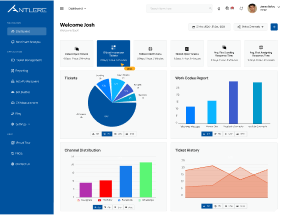How To Measure Employee Engagement
What makes employees stay, contribute, and go the extra mile? It’s not just perks or paychecks, it’s engagement. But how do you measure something so personal, invisible, and yet powerful? In this guide, we’ll explore the smartest ways to decode employee engagement in 2025, so you’re not just guessing; you’re leading.
Measure Employee Engagement Through the following metrics
Gain deeper insights into your workforce by tracking these key engagement metrics that reflect satisfaction, motivation, and overall employee experience.
1- Employee Loyalty (eNPS)
One of the best methods to measure employee satisfaction and loyalty is through the Employee Net Promoter Score (eNPS). A scale from 0 to 10 on how likely your employees are to recommend your organization as a good place to work. There are three types of employees, Promoters (9–10), Passives (7–8) and Detractors (0–6). More percentage of promoters often means a more engaged workforce, while more detractors often signal dissatisfaction or disengagement.
The eNPS or employee net promoter score is a proud ratio that can be calculated according to the following formula:
- eNPS = % of Promoters – % of Detractors
This score ranges from -100 to +100. A positive eNPS is not generally a bad sign; negative eNPS scores should be looked at more closely. When you track eNPS over time, it empowers HR teams to see the impact of internal changes and improvements.
2- Turnover Rate (Voluntary Employee Turnover)
The voluntary turnover is the employees voluntarily leaving the organization. A high voluntary attrition number can suggest poor morale, limited opportunities for advancement, or dissatisfaction with leadership. This enables organizations to locate departments (or teams) that show higher than average attrition.
Voluntary Turnover Rate = (Voluntary Separations ÷ Average Number of Employees) × 100
By focusing on voluntary exits, HR teams can distinguish between natural departures and problematic turnover. Exit interviews, combined with turnover data, help reveal trends and suggest actionable retention strategies.

3- Absenteeism (Employee Absenteeism Rate)
Absenteeism tracks how frequently workers fail to come in for work without warning beforehand. Unscheduled Frequent Absence, it could be an indication of disengagement, workplace dissatisfaction, or even burnout. Chronic absenteeism hampers productivity and can also disrupt team dynamics.
Absenteeism Rate = (Total Unscheduled Absence Days ÷ Total Available Workdays) × 100
So what if absenteeism rises but then you know what the absenteeism rate is usually a warning sign. Organizations can tackle it by reviewing workloads, providing wellness programs, or enhancing communication avenues for better employee support.
4- Engagement Survey (Employee Engagement Surveys)
Engagement surveys are broad-based instruments to gather employee feedback on numerous workplace metrics, job satisfaction, alignment with company values and people’s development opportunities. They provide an organized way to be more aware of how people feel about their work environment.
These surveys are especially useful for organizations operating in high-volume environments like BPO, where consistent feedback and fast response loops are crucial.
5- Quick Check-ins (Pulse Engagement Surveys)
The pulse survey, which is a brief and regular survey, is aimed at tracking employee engagement on an ongoing basis. These are usually done week on week or month on month and have only a few core questions unlike full engagement surveys. Which is helpful for tracking mood, workload stress, and team dynamics.
Pulse surveys allow for fast-paced study with agility. They enable leaders to make swift moves in times of waning morale or heightened stress. Eventually, pulse survey data could be correlated with productivity or retention data to find patterns.
6- One-on-One Meetings (1-on-1s)
Regular one-on-one meetings between managers and employees are vital for engagement. These meetings provide space for employees to discuss concerns, share progress, and receive feedback. When conducted effectively, they foster trust and strengthen the employee-manager relationship.
The dialogue likewise offers supervisors a look into worker troubles or passions that won’t show up in studies. When major voices are documented and followed up consistently, the employees feel that their voice has value and that it matters.
7- Exit Feedback (Exit Interviews)
This interview is done when an employee leaves from the organization. Such interviews provide a better understanding of the circumstances surrounding the exit, as well as opportunities for greater organizational improvement. Some common feedback is career stagnation, management or work-life balance.
Examining trends from exit interview data over time can allow companies to fine-tune more effective policy, improve leadership training, and retain their best performers. It can also help identify systemic issues at an organizational level. Combine that feedback with their turnover data and it can be a very powerful diagnostic tool.

8- Strategy Understanding (Understanding of Organization’s Strategy)
Engaged employees know what their company is trying to do, and how their work fits into that. Reducing potential misalignments that can slow things down when things get challenging and inspire or motivate the entire organization. Alternatively, confusion or lack of communication may disengage clients.
Companies can measure this by using specific survey questions or by focus groups. It is essential for leaders to consistently communicate strategy in various settings, such as meetings, newsletters, or town halls. Staff needs to be able to view how their work aligns with broad company goals.
9- Manager Relationship (Positive and Supportive Manager-Employee Relationship)
Engagement massively depends on the quality of the relationship between managers and their sub ordinates. While supportive managers who maintain effective communication makes employees feel appreciated and heard, bad relations have the opposite effect leading to dissatisfaction and turnover.
This can be evaluated through survey questions about how well the employee believes their manager is helping them, being fair, or communicating. When managers are given leadership training and well-defined feedback mechanisms, they will get equipped with the skills required to win the relationship battle.
10- Autonomy at Work (Level of Autonomy)
Autonomy is the opportunity that employees have to make their own choices regarding their work. More autonomy is commonly linked with higher satisfaction and engagement at work. It indicates that the company believes in people and promotes innovation.
Perceived autonomy can be measured via surveys or interviews inside the organization. Promoting flexibility, ensuring decision-making, limiting micromanagement are all ways to increase autonomy (in turn driving engagement).
11- Sense of Purpose (Sense of Accomplishment)
A major driver of engagement as employees crave a sense of purpose and ultimately, the need to know that their work is both purposeful and impactful. When employees understand that they are part of something bigger, they are more motivated and able to weather storms.
This can be measured as part of open-ended survey questions or employee story-telling exercises. Purpose can be reinforced by leaders who acknowledge individual contributions and share stories of the impact of the company as often as possible.
12- Rewards & Recognition (Compensations and Rewards)
Engagement happens with fair pay and ongoing recognition. Employees have a greater tendency to stay committed and motivated when they believe that their hard work is recognized both in salary and social recognition.
Tracking this is easy for companies through surveys, performance review data, and reward program participation rates A positive culture of recognition at every level, where small wins and big milestones are celebrated, strengthens workplace relationships and engagement.

Conclusion: Turn Insights into Impact
Measuring employee engagement isn’t a one-time task; it’s an ongoing conversation between your organization and its people. By using these 12 proven methods, you gain more than just data; you gain a deeper understanding of what drives your teams, what holds them back, and how to build a culture where they truly thrive.
But collecting insights is only half the equation. Acting on them is where the real transformation begins.
At Abacus BPO, we help organizations especially those in BPO and service-driven sectors turn employee feedback into meaningful outcomes, whether it’s improving retention, strengthening leadership, or shaping a workplace culture that people are proud to be part of.
Ready to reimagine engagement at scale?
Partner with Abacus Outsourcing and build a more connected, committed, and high-performing workforce.










